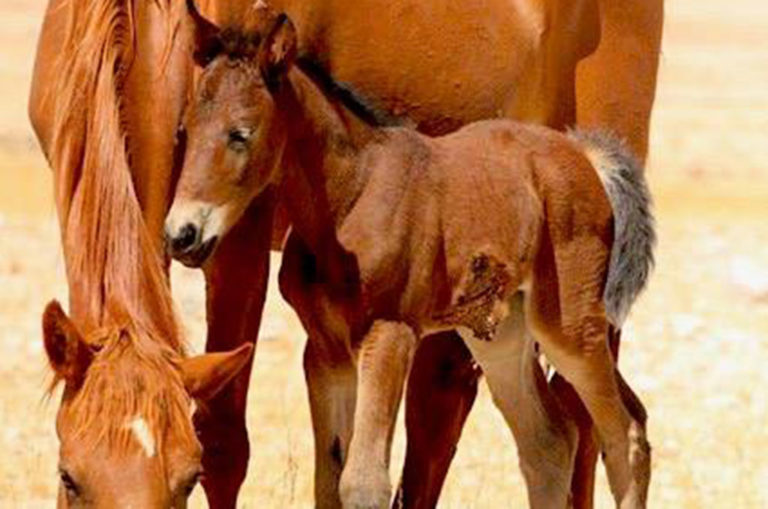The desert horses of the Namib have once again been attacked by a pack of spotted hyenas. Luckily, the latest victim, a week-old foal, has survived despite its injuries and is the last one left.

The foal has been injured after being attacked by the hyenas, most visibly on its stomach. Photo: Facebook.
According the Namibia Wild Horses Foundation, an organisation aimed at protecting horses, the number of wild horses has drastically decreased from 286 to 79 since the arrival of the hyenas in 2013.
In addition, not a single foal has survived in the last seven years due to impacts of the drought and the hyenas. The youngest mare is eight years old and the youngest horse is seven years old.

A mare and foal cross the grasslands of the Namib. Photo: Facebook/Teagan Cunniffe.
This month The Namibian reported that the Ministry of Environment and Tourism said it would remain the custodian of the horses and continue its work on relocating the hyenas.
It said the horses are “…a national heritage…” and it is their job to care for them.
The mission to relocate the hyenas first began in December 2018, but was paused due to staff holidays. The ministry’s spokesperson, Romeo Muyunda, told the newspaper the hyenas would be relocated by the end of the month.
The Foundation has wanted custodianship of the horses in order to move them away from the hyenas to a suitable location that is accessible for tourists.

Namib stallions on the grass plains. Photo: Facebook/Teagan Cunniffe.
Heavy rain in 2018 increased water and food sources for the horses, along with the hyenas moving further sparked hope that the heard would recover.
However, the hyenas moved back to the plains and started attacking the herd again. According to the Foundation, all but one of the foals born in the last few months have been killed.

The herd relaxes on the desert flats. Photo: Facebook.
It is unclear how the wild horses made the Namib Desert their home but popular theories suggest that the horses ‘broke free’ from the army forces in the area between 1915 and 1925.
For almost 100 years the horses lived in isolation in an area of about 400 km²because of a restriction on access to the area. The horses are now considered to be a breed of their own: the Namibs.
Featured image: Facebook/Teagan Cunniffe.
You may also like
Related Posts
China’s National Health Commission has published a list of controversial coronavirus treatments that have animal...
read more
Warmer sea temperatures in the summer months, especially in February, were recorded and are believed...
read more
The latest report indexing the world's happiest countries has highlighted the important role of...
read more